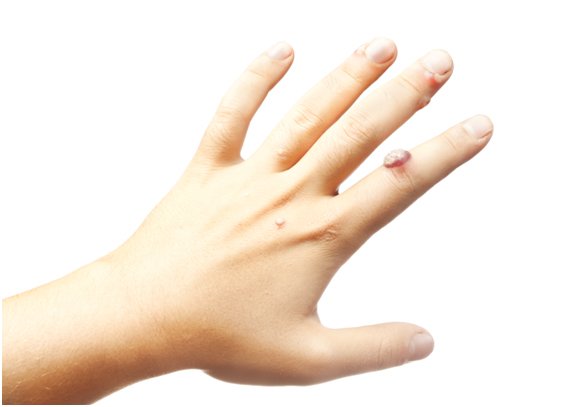Six months ago, I noticed I had a small round, raised spot on the pad of my right index finger. It was hard and flat, a light gray in color. I looked more closely at it. It wasn’t a blister or a burn. It wasn’t part of a rash. It didn’t itch or burn, but it was tougher than the skin around it.
A month later, it was STILL there.
Two months later, it was STILL there. It stayed just like it was: a small, round, raised, flat and light gray spot on the pad of my finger.
Hmm. Could it be a wart? When I showed it to my doctor the following week at a checkup, he confirmed my suspicion. That spot on my finger was a wart.
I’m not alone. After acne, warts are the most common and annoying skin condition that people want to get rid of.
Warts are a viral infection of the outer layer of your skin called your epidermis. It’s caused by the human papillomavirus, or HPV. There are about 100 different subtypes, and the infected skin grows into a thickened mass that juts out from the normal skin surrounding it. They can be different colors, too, such as light gray, yellow, brown, even gray-black. Warts are more often found on your hands and feet, and children are more likely to be affected than adults.
There are several main types of warts found in humans, including common warts, flat warts, palmar (on the palm of your hand), plantar (on the sole of your foot), and genital warts. Most warts are fairly flat but some grow outward with a “bushy” cauliflower-like appearance.
Although annoying and unsightly, most warts are benign unless they are on an obvious place, like on your face, or grow on a weight bearing surface, like the bottom of your foot. When a wart creates pressure or pain when you walk on it, it should be removed as soon as reasonably possible.
How do you remove a wart? Most treatments work by damaging or destroying the infected skin, triggering your immune system to address the wounded area, which attacks the virus that is living there and helps eliminate it.
If you do nothing, nearly half of all warts will eventually go away by themselves, without any treatment, within about 2 years for children and within 2-5 years for adults.
Most wart treatments involve applying a topical product to the wart for several weeks to about 3 months. For many people, this will work, but some warts stubbornly refuse to die.
Going to the doctor gives you the option of freezing the wart or using a very concentrated chemical on it, more expensive and possibly leaving a scar.
The 2 most common approaches are to chemically “peel” the skin over time with a liquid or gel containing salacylic acid or other caustic chemical. There are wart removal products with salacylic acid and others that cause a freezing effect, both available without a prescription. Most Compound W® formulations contain salacylic acid as a concentrated liquid or as a patch.
Here are 6 Tips to Help Treat Warts Effectively:
- Remove the Top Layer First
To enhance the penetration of your remedy into the wart, ALWAYS soak it in warm water for at least 5-10 minutes, and then remove the upper layers of the wart with sandpaper or an emery board.
- Never Reuse Emery Board or Sandpaper
I prefer to use sandpaper so I can throw it away. DON’T reuse the sandpaper or emery board used on your wart because it is now contaminated with the HPV virus that you just scraped off, and could re-infect you.
- Protect The Skin Around Your Wart
Avoid using abrasives like sandpaper or emery boards on the normal skin around your wart, and apply your treatment ONLY to the wart itself. Injuring nearby healthy skin makes it easier for a wart to spread.
- Give it Time
It takes weeks to respond to wart removal treatments and up to 3 months for warts to completely go away, and no treatment works on everyone. If you don’t notice improvement after 2 months, try something else.
- Try Salicylic Acid First
Concentrated salicylic acid has the best overall track record for removing warts. I suggest using the most concentrated version of gel, then covering it with a bandage or even duct tape.
- Combine Your Approach
For stubborn warts, both freezing and using a topical agent will give better results than using only one at a time.


